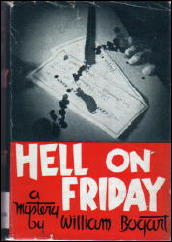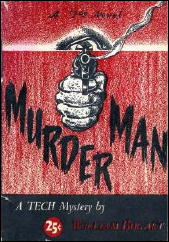Sat 15 Oct 2011
A 1001 MIDNIGHTS Review: WILLIAM BOGART – Hell on Friday.
Posted by Steve under 1001 Midnights , Pulp Fiction , Reviews[2] Comments
by Bill Pronzini

WILLIAM [G.] BOGART – Hell on Friday. Jonathan Swift, hardcover, 1941. Also published as Murder Man, Tech Mysteries, digest paperback, no date [1943?]
William G. Bogart was a prolific pulp writer in the Thirties and Forties. His chief claim to fame is that he ghosted a handful of the Doc Savage novels that have become so popular in paperback reprint. At his best, he was only a fair novelist; Hell on Friday is noteworthy primarily as one of only two mystery novels with a pulp publishing background. (The other is William P. McGivern’s But Death Runs Faster, published seven years later — a much better mystery novel but lacking the range of pulp lore and true pulpy feel of the Bogart book.)
Hell on Friday‘s protagonist, private eye Johnny Saxon, is a former “prince of the pulps” who quit writing after three years of phenomenal success because “the business had lost its kick for him [and] his stuff went stale.” His partner, Moe Martin, is “the loneliest literary agent in New York” — an emotional sponge who can lose himself in any narrative and therefore is incapable of telling the good from the bad.

Saxon is hired by Joe Rogers, head of Rogers Publishing Company, a chain publisher of some twenty-two pulp magazines, to investigate the dubious business practices of a rival publisher, Sam Sontag.
Rogers also wants him to help persuade a love-pulpeteer who writes under the name Dulcey Dickens to sign an exclusive contract with his firm. Murder, the appearance of a racketeer named Jasper Ward, the disappearance of Dulcey Dickens, and other complications carry the narrative.
The plot isn’t particularly clever or exciting, and the solution holds no real surprises. Still, there is a certain charm to Hell on Friday (the title refers obliquely to the fact that Friday was payday for the legion of pulp writers, and often make-up day for the various magazines as well).
Saxon and Moe Martin are engaging characters (as is Dulcey Dickens), and the pulp setting is well drawn and packed with details fascinating to anyone with an interest in that vanished era. Saxon also stars in two other novels by Bogart — Murder Is Forgetful (1944) and The Queen City Murder Case (1946).
———
Reprinted with permission from 1001 Midnights, edited by Bill Pronzini & Marcia Muller and published by The Battered Silicon Dispatch Box, 2007. Copyright © 1986, 2007 by the Pronzini-Muller Family Trust.
Bibliographic Note: All three novels are available in an omnibus edition (Hell on Friday: the Johnny Saxon Trilogy) published by Altus Press, 2010).
October 16th, 2011 at 5:40 pm
Mystery File strikes again. First I read about the trilogy: then I order it. What a goldmine this site is for books I have never been aware of.
(BTW, I think I tried one–at least–of Carolyn Hart’s mysteries, tough I have no memory of it..
In any event , thanks to the review here I have also put a hold on DEATH ON DEMAND to be sent to my local branch of the L.A. Public Library)
October 16th, 2011 at 6:20 pm
Even at $35, that Altus Press trilogy is worth the money. All three books are hard to find in their original editions.